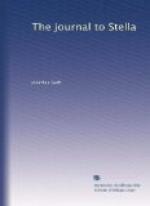11 See Letter 31, note 10.
12 Sir John St. Leger (died 1743) was M.P. for Doneraile and a Baron of the Exchequer in Ireland from 1714 to 1741. His elder brother, Arthur, was created Viscount Doneraile in 1703.
13 “Relation of the Facts and Circumstances of the Intended Riot on Queen Elizabeth’s Birthday.”
14 The Conduct of the Allies.
15 See Letter 9, note 18.
16 The first motto was “Partem tibi Gallia nostri eripuit,” etc. (Horace, 2 Od. 17-24).
17 See Plautus’s Amphitrus, or Dryden’s Amphitryon.
18 It is not known whether or no this was Dr. William Savage, Master of Emmanuel College, Cambridge. No copy of the sermon—if it was printed—has been found. See Courtenay’s Memoirs of Sir William Temple.
19 Of The Conduct of the Allies, a pamphlet which had a very wide circulation. See a paper by Edward Solly in the Antiquarian Magazine, March 1885.
20 Allen Bathurst, M.P. (1684-1775), created Baron Bathurst in December 1711, and Earl Bathurst in 1772. His second and eldest surviving son was appointed Lord Chancellor in the year preceding the father’s death. Writing to her son in January 1711 (Wentworth Papers, 173), Lady Wentworth said of Bathurst, “He is, next to you, the finest gentleman and the best young man I know; I love him dearly.”
21 See Letter 9, note 17.
22 See Letter 16, note 20.
23 Swift is alluding to the quarrel between Lord Santry (see Letter 23, note 2) and Francis Higgins (see Letter 34, note 10), which led to Higgins’s prosecution. The matter is described at length in Boyer s Political State, 1711, pp. 617 seq.
24 See Letter 19, note 1.
25 No doubt the same as Colonel Newburgh (see Journal, March 5, 1711-12).
26 Beaumont (see Letter 1, note 2 and Letter 26, Jul. 6, 1711).
27 See Letter 31, note 1.
28 Cf. Letter 15, Feb. 9, 1710-11.
29 See Letter 35, note 3.
Letter 36.
1 See Letter 34, note 15. Debtors could not be arrested on Sunday.
2 Sir George Pretyman, Bart., dissipated the fortune of the family. The title became dormant in 1749.
3 See the Introduction.
4 For the Whites of Farnham, see Manning and Bray’s Surrey, iii. 177.
5 The Conduct of the Allies.
6 The Percevals were among Swift’s principal friends in the neighbourhood of Laracor. In a letter to John Temple in 1706 (Forster’s Life of Swift, 182) Swift alludes to Perceval; in spite of different views in politics, “I always loved him,” says Swift, “very well as a man of very good understanding and humour.” Perceval was related to Sir John Perceval, afterwards Earl of Egmont (see Letter 18, note 15).
7 See Letter 1, note 12.
8 See Letter 8, note 14.
9 The Examiner was resumed on Dec. 6, 1711, under Oldisworth’s editorship, and was continued by him until July 1714.




